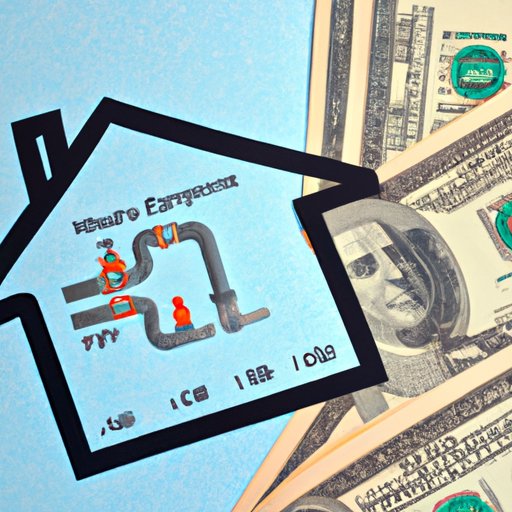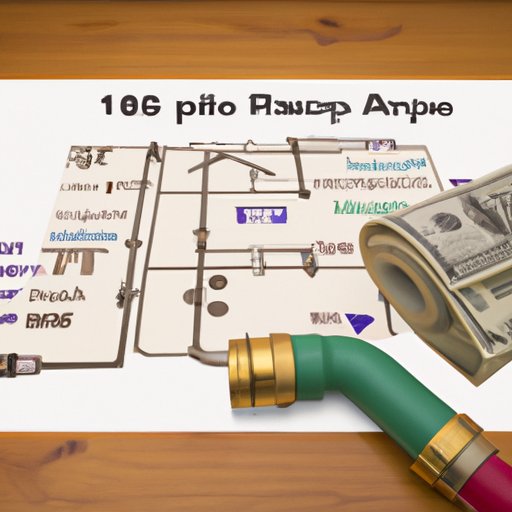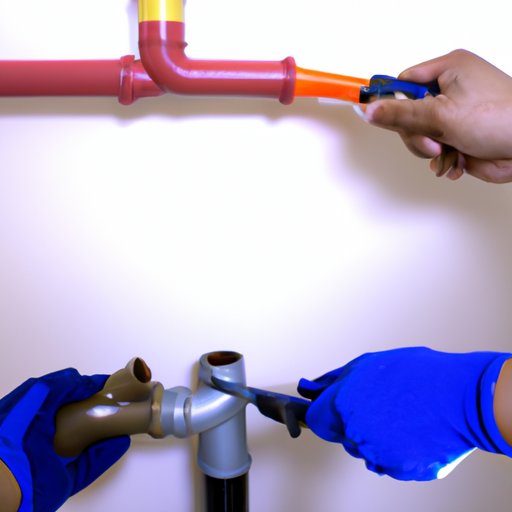Introduction
Repiping is the process of replacing old, worn-out plumbing pipes with new ones. It’s often necessary if the existing pipes are corroded or leaking, or if a home needs to be upgraded to meet modern building codes. Though it’s a major project that requires considerable time and effort, repiping a house can be worth it in the long run, as it reduces the risk of water damage and increases the value of the property. But before you embark on this undertaking, it’s important to understand the cost of repiping a house.

A Comprehensive Guide to Estimating the Cost of Repiping a House
The cost of repiping a house will vary depending on factors such as the type of pipes used, the size and layout of the home, and local labor costs. However, there are some general estimates that can help you get a better idea of the overall cost of repiping a house.

Exploring the Average Price for Repiping a Home
According to HomeGuide, the average cost of repiping a house ranges from $1,500 to $15,000. This wide range reflects the fact that costs can vary greatly depending on the size and complexity of the job, along with the materials and labor involved. Generally speaking, smaller homes tend to be on the lower end of the spectrum, while larger homes may require more extensive work and thus cost more.
How Much Does It Cost to Replace the Plumbing in a Home?
The exact cost of replacing the plumbing in a home depends on several factors, including the type of pipes used, the accessibility of the pipes, the size and layout of the house, and local labor costs. Let’s look at each of these in more detail.
What Factors Affect the Cost of Repiping a House?
There are several key factors that will influence the cost of repiping a house. Here’s a closer look at each one:
Type of Pipes Used
The type of pipes used for repiping will affect the cost of the project. Copper pipes are generally the most expensive option, but they are also highly durable and resistant to corrosion. PVC pipes are often more affordable, but they are not as strong and may need to be replaced sooner. Other types of pipe materials, such as PEX, may also be used, depending on the needs of the project.
Accessibility of the Pipes
The ease of access to the pipes will also play a role in the cost of repiping. If the pipes are easily accessible, such as in an unfinished basement, the cost of the project may be lower. However, if the pipes are located in a wall or other hard-to-reach area, it will take more time and effort to repipe them, which could increase the cost.
Size and Layout of the House
The size and layout of the house will also factor into the cost of repiping. Larger homes require more materials and labor, so they tend to be more expensive than smaller homes. Additionally, the layout of the house may affect the cost, as it can affect the accessibility of the pipes and the amount of materials required.
Local Labor Costs
Labor costs can also have a significant impact on the overall cost of repiping a house. The rate charged by plumbers can vary greatly from one location to another, so it’s important to research local rates before committing to a project.
A Breakdown of the Cost of Repiping a House
Now that we’ve explored the factors that affect the cost of repiping a house, let’s break down the cost into two main categories: materials and supplies, and labor costs.
Materials and Supplies
The cost of materials and supplies can range from $500 to $2,500, depending on the type of pipes used, the size of the house, and the number of fixtures that need to be replaced. Copper pipes are usually the most expensive option, while PVC pipes are typically cheaper. Additionally, the cost of fittings, connectors, and other supplies will need to be taken into account.
Labor Costs
Labor costs can range from $500 to $12,500, depending on the size and complexity of the job. Plumbers typically charge an hourly rate, and the cost of the project will depend on how many hours it takes to complete the work. In addition to the labor costs, there may also be additional charges for services such as installation of new fixtures and disposal of old pipes.
How to Save Money When Repiping Your Home
If you’re looking to save money when repiping your home, there are a few options to consider. First, you can research low-cost alternatives to copper pipes, such as PVC or PEX. You can also shop around to compare prices from different suppliers. Additionally, you may be able to save money by doing some of the work yourself, such as installing the new pipes.

The Pros and Cons of DIY Repiping vs Professional Repiping
Before deciding whether to do it yourself or hire a professional, it’s important to consider the pros and cons of both options. DIY repiping can be a great way to save money, but it’s important to remember that mistakes can be costly. On the other hand, hiring a professional ensures that the job is done right, but it can be expensive. Ultimately, the decision should be based on your budget and comfort level with plumbing projects.
Conclusion
Repiping a house can be a daunting task, but it’s important to understand the costs associated with the project. The cost of repiping a house can vary greatly depending on factors such as the type of pipes used, the accessibility of the pipes, the size and layout of the house, and local labor costs. Additionally, there are ways to save money when repiping your home, such as researching low-cost alternatives and considering doing it yourself. Whether you decide to hire a professional or do it yourself, it’s important to do your research and understand the full scope of the project before getting started.
(Note: Is this article not meeting your expectations? Do you have knowledge or insights to share? Unlock new opportunities and expand your reach by joining our authors team. Click Registration to join us and share your expertise with our readers.)
